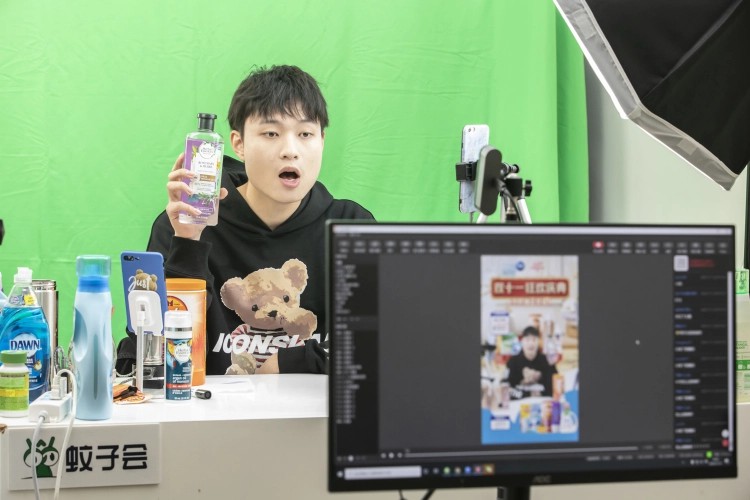 图片来源:QILAI SHEN—GETTY IMAGES
图片来源:QILAI SHEN—GETTY IMAGES
随着零售商和品牌逐渐接受通过直播购物来吸引消费者,这种虚拟形式便成为了2020 年新冠疫情之下的热门趋势。Qurate Retail集团对这一全球现象有着独到的看法,我们的HSN团队早在约40年前便在电视上开办视频直播购物节目,如今我们的QVC和HSN品牌已经成立世界上颇具规模的视频商务平台,惠及3亿8千万家庭。看到这么多公司接纳并提升这种强力的零售形式,我们十分高兴。
作为美国全国零售联合会(National Retail Federation)的主席,我亲眼目睹了零售行业在这个艰难时刻所表现出来的非凡韧性和创新精神,零售商们在几周或几个月的时间内就部署了新的购物方式,放在平时可能需要几年的时间。直播购物通过视频直播来分享产品,回答问题并进行销售,用户在这个过程中能够远程观看、聊天和购买。这种形式是原本以电视为中心的模式的自然发展结果,近些年来逐渐得到了认同。而现在,为了应对疫情造成的购物限制,世界各地的零售商和品牌都在竞相将实时互动视频的体验加入到营销组合策略中。
目前的直播购物热潮源自前几年的中国,当时一些网络红人通过视频直播应用程序带着粉丝一起逛纽约和洛杉矶的精品店,并一路分享和介绍产品。这些虚拟之旅让观众得以一睹异国风情,还可以发掘和购买在中国难以买到的产品。
与此同时,中国的电商巨头开始通过视频来推广直播活动,邀请名人直播聊天并无缝连接购物消费。2019年双十一光棍节,知名网红薇娅在淘宝进行8小时的直播销售活动,吸引了超过4300万名顾客。根据此前的预计,2020年直播购物会在中国产生大约1360亿美元收入。不过,中国的模式在财务上是否可行还是一个未知数,毕竟依赖名人带货吸引观众的做法花费不菲,而且并不能够保证提高品牌忠诚度或拉拢回头客。
美国和欧洲则出现了多种多样的模式。和中国一样,把商务视频投放到知名电商或社交应用程序仍然是引流的领先做法。Instagram已经在其应用程序中添加了购物功能,Instagram Live也是如此。Facebook正在开发原生直播购物工具,有媒体标题直言《Facebook Live是新QVC》。另外,沃尔玛(Walmart)最近开始与TikTok合作,在直播中推销产品。亚马逊(Amazon)也推出了Amazon Live,观众可以在节目中购物,品牌也能够利用其配套工具进行编程。
其他公司正在开发线上市场发展直播购物,或者帮助零售商和品牌利用直播吸引观众数字化参与。一些公司也在尝试更加个性化的直播,为顾客和在店内购物的人或员工建立联系,或者允许用户直接互相销售。
这些围绕直播购物的活动热潮反映了几大趋势。新技术的出现让人们更方便制作和分享视频体验,数字媒体消费得以爆炸性增长。名人与社交红人对购物决策的影响也越来越大。新冠疫情促使数百万消费者在线上与零售商和品牌互动,许多人在疫情之后的很长一段时间内也会继续这么做。
直播购物在铺天盖地之际也会继续发展演化,带来无限可能。社交媒体上的人工智能或许可以让我们为每位客户提供完全个性化的直播渠道和互动内容,专为他们量身定制和精选。又或者,虚拟现实技术能够让我们把顾客带到时装秀直播现场的前排座位,旁边就坐着一位亲切的主持人,已经准备好回答问题和接受订单。
短期内,这个行业的新来人士需要克服一些更实际的挑战,比如直播购物的线上引流成本正在迅速上升。无论是支付名人巨额费用,还是大举投资付费媒体,这些营销成本可能会很快吞噬预算。他们必须时刻关注经济。如果开价不够有竞争力,或者无法有效服务客户和分销产品,成功会转瞬即逝。
投身直播领域的公司也应该了解到,视频购物并不仅仅关于最新技术或者网络红人。太多新入局者只关注表面而不重视实质。那些坚持下来的人会明白,正如以前那些生意兴隆的百货商场所做的那样,成功的关键在于建立持久的客户关系。零售的基本需求从未改变,即便是在虚拟世界中,它依然关乎人际关系的力量和发现的乐趣。在喜欢的商店中闲逛,进行有趣的对话,了解产品背后的故事,并从中获得启发。
看到这种有着40年历史的商业模式重焕青春,其实十分有趣。根据最近的发展趋势,只要我们不让技术脱离人性,它就有可能给当今的居家消费者带来最好的实体购物体验。(财富中文网)
麦克•乔治是Qurate Retail集团的主席兼首席执行官,该集团旗下有QVC、HSN、Zulily和Cornerstone这些品牌。此外,他也是美国全国零售联合会的主席。
译者:秦维奇
随着零售商和品牌逐渐接受通过直播购物来吸引消费者,这种虚拟形式便成为了2020 年新冠疫情之下的热门趋势。Qurate Retail集团对这一全球现象有着独到的看法,我们的HSN团队早在约40年前便在电视上开办视频直播购物节目,如今我们的QVC和HSN品牌已经成立世界上颇具规模的视频商务平台,惠及3亿8千万家庭。看到这么多公司接纳并提升这种强力的零售形式,我们十分高兴。
作为美国全国零售联合会(National Retail Federation)的主席,我亲眼目睹了零售行业在这个艰难时刻所表现出来的非凡韧性和创新精神,零售商们在几周或几个月的时间内就部署了新的购物方式,放在平时可能需要几年的时间。直播购物通过视频直播来分享产品,回答问题并进行销售,用户在这个过程中能够远程观看、聊天和购买。这种形式是原本以电视为中心的模式的自然发展结果,近些年来逐渐得到了认同。而现在,为了应对疫情造成的购物限制,世界各地的零售商和品牌都在竞相将实时互动视频的体验加入到营销组合策略中。
目前的直播购物热潮源自前几年的中国,当时一些网络红人通过视频直播应用程序带着粉丝一起逛纽约和洛杉矶的精品店,并一路分享和介绍产品。这些虚拟之旅让观众得以一睹异国风情,还可以发掘和购买在中国难以买到的产品。
与此同时,中国的电商巨头开始通过视频来推广直播活动,邀请名人直播聊天并无缝连接购物消费。2019年双十一光棍节,知名网红薇娅在淘宝进行8小时的直播销售活动,吸引了超过4300万名顾客。根据此前的预计,2020年直播购物会在中国产生大约1360亿美元收入。不过,中国的模式在财务上是否可行还是一个未知数,毕竟依赖名人带货吸引观众的做法花费不菲,而且并不能够保证提高品牌忠诚度或拉拢回头客。
美国和欧洲则出现了多种多样的模式。和中国一样,把商务视频投放到知名电商或社交应用程序仍然是引流的领先做法。Instagram已经在其应用程序中添加了购物功能,Instagram Live也是如此。Facebook正在开发原生直播购物工具,有媒体标题直言《Facebook Live是新QVC》。另外,沃尔玛(Walmart)最近开始与TikTok合作,在直播中推销产品。亚马逊(Amazon)也推出了Amazon Live,观众可以在节目中购物,品牌也能够利用其配套工具进行编程。
其他公司正在开发线上市场发展直播购物,或者帮助零售商和品牌利用直播吸引观众数字化参与。一些公司也在尝试更加个性化的直播,为顾客和在店内购物的人或员工建立联系,或者允许用户直接互相销售。
这些围绕直播购物的活动热潮反映了几大趋势。新技术的出现让人们更方便制作和分享视频体验,数字媒体消费得以爆炸性增长。名人与社交红人对购物决策的影响也越来越大。新冠疫情促使数百万消费者在线上与零售商和品牌互动,许多人在疫情之后的很长一段时间内也会继续这么做。
直播购物在铺天盖地之际也会继续发展演化,带来无限可能。社交媒体上的人工智能或许可以让我们为每位客户提供完全个性化的直播渠道和互动内容,专为他们量身定制和精选。又或者,虚拟现实技术能够让我们把顾客带到时装秀直播现场的前排座位,旁边就坐着一位亲切的主持人,已经准备好回答问题和接受订单。
短期内,这个行业的新来人士需要克服一些更实际的挑战,比如直播购物的线上引流成本正在迅速上升。无论是支付名人巨额费用,还是大举投资付费媒体,这些营销成本可能会很快吞噬预算。他们必须时刻关注经济。如果开价不够有竞争力,或者无法有效服务客户和分销产品,成功会转瞬即逝。
投身直播领域的公司也应该了解到,视频购物并不仅仅关于最新技术或者网络红人。太多新入局者只关注表面而不重视实质。那些坚持下来的人会明白,正如以前那些生意兴隆的百货商场所做的那样,成功的关键在于建立持久的客户关系。零售的基本需求从未改变,即便是在虚拟世界中,它依然关乎人际关系的力量和发现的乐趣。在喜欢的商店中闲逛,进行有趣的对话,了解产品背后的故事,并从中获得启发。
看到这种有着40年历史的商业模式重焕青春,其实十分有趣。根据最近的发展趋势,只要我们不让技术脱离人性,它就有可能给当今的居家消费者带来最好的实体购物体验。(财富中文网)
麦克•乔治是Qurate Retail集团的主席兼首席执行官,该集团旗下有QVC、HSN、Zulily和Cornerstone这些品牌。此外,他也是美国全国零售联合会的主席。
译者:秦维奇
Livestream shopping is one of the hottest trends to emerge from a pandemic-scarred 2020, as retailers and brands embrace this virtual approach to engaging consumers. At Qurate Retail, we have a unique vantage point to observe this global phenomenon, as our HSN team invented live video shopping on TV about 40 years ago, and today our QVC and HSN brands form one of the world’s largest video commerce platforms, reaching 380 million homes. We’re excited to see so many companies embrace and elevate this powerful form of retailing.
As chair of the National Retail Federation (NRF), I’ve observed firsthand the remarkable resilience and innovative spirit of our industry in this difficult hour, with retailers deploying new shopping approaches in weeks or months that might have taken years in ordinary times. Livestream shopping—using live video to share products, answer questions, and close sales with customers who are joining remotely to watch, chat, and buy—is a natural outgrowth of the original TV-centered model and has been gradually gaining traction in recent years. But now, responding to shopping restrictions imposed by the pandemic, retailers and brands worldwide are racing to add live, interactive video experiences into their marketing mix.
The current livestream shopping craze has its roots in China in the mid-2010s, when influencers began using live video apps to take their fans with them as they traveled to boutiques in New York or Los Angeles, sharing and explaining products along the way. These virtual journeys offered viewers a glimpse of exotic locations with the option to discover and buy products that were not readily available in China.
China’s e-commerce giants, meanwhile, began offering live events via video, hosted by celebrities, with live chat and seamless purchasing. Chinese consumers loved it. On Singles Day 2019, Taobao’s sales event featured an eight-hour livestream with popular influencer Viya that attracted more than 43 million customers. In 2020, livestream shopping was projected to generate about $136 billion in revenue in China. Nonetheless, the financial viability of China’s approach remains a question mark, in part because of its reliance on celebrities to attract audiences, a costly approach that doesn’t always translate into brand loyalty and repeat purchasing.
In the U.S. and Europe, a variety of approaches are emerging. As in China, the leading model involves adding video commerce to popular e-commerce or social apps to tap their audiences and influencers. Instagram has added shopping capabilities throughout its apps, including Instagram Live. Facebook is developing native livestream shopping tools, with one headline announcing that “Facebook Live is the new QVC.” Walmart recently began partnering with TikTok to offer its products via livestream. Amazon launched Amazon Live, with an array of shoppable shows and a suite of tools that enable brands to create their own programming.
Other players are developing online marketplaces for livestream shopping or are helping retailers and brands use livestreams to engage audiences on their digital properties. Some are experimenting with more personalized livestreams that connect customers to shoppers or staff in-store or allow users to sell directly to each other.
This whirlwind of activity around livestream shopping reflects several megatrends. Digital media consumption is exploding, as new technologies make it easier than ever to create and share video-based experiences. Celebrities and social influencers are having a growing impact on purchase decisions. COVID-19 has pushed millions of consumers to increasingly interact with retailers and brands online, and many will likely continue to do so long after the pandemic is over.
As livestream shopping expands, it will continue to evolve, and the possibilities are dazzling. Perhaps artificial intelligence on social media will enable us to provide each customer with a fully individualized channel of live, interactive content, curated just for them. Maybe virtual reality will allow us to transport the customer to a front-row seat at a livestream fashion show, right next to a friendly host who is ready to answer questions and take an order.
In the near term, new entrants need to conquer more practical challenges, such as the rapidly rising cost of attracting online traffic to live shopping. Whether paying a high-profile celebrity or investing heavily in paid media, these marketing costs can quickly chew up budgets. New players must also keep an eye on economics. Those who fail to offer competitive prices, as well as to efficiently service customers and distribute products, will find success short-lived.
Companies jumping into livestreaming also need to learn that video shopping is about more than the latest technology or the influencer of the moment. Too many new players seem intent on flash over substance. Those who endure will understand that the key to success, as it was for the great emporiums of old, is building lasting relationships, customer by customer. The basic needs that have always defined retail haven’t changed. Even in the virtual world, it’s still about the power of human connection and the joy of discovery—wandering into your favorite shop, having interesting conversations, learning the stories behind the products, and getting inspired.
It’s fun to see this 40-year-old business model suddenly young again. The latest developments offer the potential to bring the best of physical shopping to today’s stay-at-home consumer, as long as we bring our humanity along with the technology.
Mike George is president and CEO of Qurate Retail, Inc., comprising QVC, HSN, Zulily, and the Cornerstone Brands. He is also chairman of the National Retail Federation.






